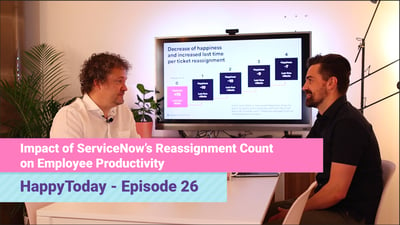From our HappinessScore™ Report, which is built from 1 million customer responses, Pasi and Sami go through the successful and unsuccessful company cases, showing you what to do and what not to do.
The data that leads to the findings was taken from customers who have been using HappySignals products for a year or more. Sami and the Customer Success Team looked at data from the customers first 2 months using the product and compared it to the last 2 months.
They found that on average customers were able to increase their happiness by 17%. A huge increase. However, this was not the only thing that was impressive. They also found that customers increased their time saved by 26%. That means nearly an hour saved per each ticket.
But what really affects customers to make this kind of difference?
The main dominating reason for customers being successful, is whether the data has been shared with several partners, teams or people. Sharing the data openly with all people involved, leads to a greater amount of people having an input on the case, instead of one person owning the data.
In comparison, Sami and the Customer Success team found that the most unsuccessful companies were holding onto the data and not sharing it with any other parties.
Other reasons for companies success were whether they were developing tools and channels, and making changes in their service management areas. For example, one partner shared a story that they developed a service portal in a way that they can now save 1 hour per ticket.
Another example of a HappySignals customer is Wilhelmsen. They originally outsourced their whole IT to an external vendor. Since doing so, they had negative scores in happiness, however the productivity went up. After 12 months of analysing results, they made some small changes relating to starting a conversation. This was due to a cultural difference, with the employees from Wilhelmsen located in Norway and the external IT vendor coming from India. By creating this change they were able to make a 72% impact in their happiness in 12 months as well as a 40% increase in productivity.
You can download and access the full Happiness Score™ Report here



